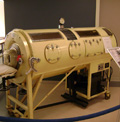 The 20th century picked up where the 19th had left off: Vaccinology had enjoyed some major breakthroughs as scientists started to better understand the causes of several infectious diseases. But much misery was still being routinely inflicted by polio, whooping cough, yellow fever, measles and others.
The 20th century picked up where the 19th had left off: Vaccinology had enjoyed some major breakthroughs as scientists started to better understand the causes of several infectious diseases. But much misery was still being routinely inflicted by polio, whooping cough, yellow fever, measles and others.
In the wake of the Spanish-American War, US army researchers demonstrated that mosquitoes were to blame for the spread of Yellow Fever – a disease which had caused thousands of casualties during the conflict. This was one of several important steps in understanding how infection spread, helping scientists develop methods to protect against the disease.
Shortly afterwards, in 1905, the contagious nature of polio was discovered. A series of experiments in Sweden by Ivar Wickman showed firstly that polio could be spread from person to person and secondly that the disease could be present in people who did not have severe symptoms associated with infection.
European researchers’ contribution to the field was considerable. In 1906, Belgian scientists Jules Bordet and Octave Gengou isolated Bordetella Pertussis, the bacterium which causes whooping cough. Two years later in Vienna, it was shown that a virus was the culprit in causing polio.
By 1916, more pieces were being added to the immunological puzzle. French researchers Charles Nicolle and Ernest Conseil showed that measles patients have specific protective antibodies in their blood and that serum from these patients could be used to protect against the disease. The effectiveness of vaccines was also developing quickly, with the 1926 development of the first adjuvanted vaccine. This was achieved by treating diphtheria toxoid with aluminium salts which helped to amplify the effect of the vaccine.
Around the same time, it became apparent that not everyone was comfortable with the practice of vaccination. Whilst, as today, most people saw most vaccines as exceptional success stories there were those who resisted vaccination, especially compulsory vaccination. In one example of energetic opposition to mandatory inoculation in the US, an armed mob led by a retired army lieutenant ran health officers out of Georgetown, Delaware.
Despite these small pockets of dissent, vaccinology continued to advance. Polio research enjoyed several leaps forward, including work by an Australian team which suggested there was more than one type of poliovirus.
But in these early days of research there were bound to be mistakes made, and there were. In New York and Philadelphia, early polio vaccine trials were conducted in more than 20,000 people. These studies would end in tragedy with several participants dying or suffering other reactions. The episode put a severe dent in the research effort and shook public confidence in vaccines.
The late 1930s saw the development of a mass-produced Yellow Fever vaccine in the US and proof that a new whooping cough vaccine was effective.
However, war in Europe was just around the corner, diverting the focus of some government research labs and sparking a diphtheria outbreak. In 1943 alone there was one million cases in Europe (not including the Soviet Union), with 50,000 deaths.
The diversion of resources to the war effort did not always spell bad news for vaccinologists. The need to protect US troops in the Pacific against Japanese encephalitis led to the swift deployment of a new vaccine. Despite not having been extensively tested, the vaccine protected thousands of American soldiers.
Politics too played its part in advancing vaccination. With the US fast becoming the dominant force in technological development, it was natural that some of the major breakthroughs came from its labs. And, along with America’s financial clout, it had a president who knew the ravages of disease first hand.
Franklin D. Roosevelt had suffered from polio and used a radio address to put the issue on the national agenda. In a deft rhetorical move, he likened the battle against disease to the fight against tyranny overseas.
“The dreaded disease that we battle at home, like the enemy we oppose abroad, shows no concern, no pity for the young. It strikes—with its most frequent and devastating force— against children. And that is why much of the future strength of America depends upon the success that we achieve in combating this disease.”
International efforts against disease were also being mobilised. The International Tuberculosis Campaign, which kicked off in 1947 and ran until 1951, saw 22 million people given the BCG vaccine. It initially began in Europe after the war but its scope was broadened to other continents thanks to a $2 million contribution by UNICEF.
By the midway point in the 20th century, the promise of vaccines was becoming a reality in the most developed corners of the globe. In the US, the last know cases of naturally occurring smallpox in were recorded in 1949, showing that a concerted vaccination effort made the goal of eradication seem possible.
Also of major significance was a breakthrough by Boston scientists in culturing viruses – a feat for which they would later win the Nobel Prize in Physiology or Medicine.
The scientists showed that they could grow polioviruses in the lab using skin and muscle tissue. This effectively ended the reliance on using live monkeys for growing and testing viruses, meaning polio research was no longer restricted to facilities that could house large numbers of experimental animals. This paved the way for simpler, cheaper methods of producing large volumes of viruses for study and production.
The scene was set for further breakthroughs in the war against infectious diseases.
Sources:
www.historyofvaccines.org
Ian Glynn and Jenifer Glynn, The Life and Death of Smallpox
Matthew Maty, The Advantages of Early Inoculation
Michael B. A Oldstone, Viruses, Plagues, & History
Herve Bazin, L’Histoire des Vaccinations
This article is part of a series compiled by Vaccines Today to raise awareness of European Immunization Week 2011 which runs from 23-30 April





Anonymous
June 19th, 2014
Is this copyrighted? or can I use this as a guideline for my essay?
Gary Finnegan
June 27th, 2014
The facts are not copyrighted but the words themselves are. If you quote directly you must cite the source; if you paraphrase the ideas it’s not essential – but welcome.
Another good resource on this topic is the History of Vaccines website run by the University of Philadelphia in the US.